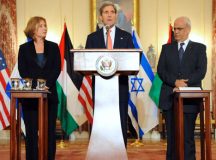The Hassassian and Cohen-Almagor document is commendable for its embrace of mutual recognition, respect and dialogue, even if it contains some elements that would be unacceptable to most Israelis.
Though it contains much that can be challenged, the joint paper by Professor Manuel Hassassian and Professor Raphael Cohen-Almagor published in Fathom is welcome for two reasons: first the support shown for the parallel recognition of Israel’s Jewish character alongside recognition of a Palestinian state; and second, the positive approach shown to breaking the deadlock through constructive dialogue, rather than mutual recrimination or boycott.
It is particularly noteworthy that Professor Hassassian accepts that lasting peace means acknowledging the ‘Jewish character of Israel’ alongside Israeli recognition of the State of Palestine. In doing so he places himself in line with the framework agreement that President Obama put to both leaders in March, in contrast to the strong opposition shown by President Mahmoud Abbas to this principle.
Former Palestinian prisoners affairs minister Ashraf al Ajrami showed similar courage at this year’s Herzliya Conference on 10 June. He told the delegates, ‘I am opposed to saying no to the recognition of Israel as the nation state of the Jewish people,’ whilst adding, ‘there has to be a precondition that the Israelis will recognise the Palestinian right to the State of Palestine.’
At the same panel, Palestinian pollster Khalil Shikaki also criticised the Palestinian leadership’s treatment of this issue. He pointed out that until a few years ago, a large majority of Palestinians were in favour of accepting Israel’s Jewish character, if acceptance came at the end of a process in which all other issues were resolved.
The willingness of the Palestinian ambassador to recognise Israel’s Jewish character is the most remarkable element of this document’s admirable attempt to bridge the current gaps. It is incumbent on Israeli and Palestinian political leaders and thought leaders to think positively, to legitimise the language of mutual respect and compromise, and to reject the language of despair that has become all too common.
The vision of a shared educational curriculum teaching respect and tolerance, with mandatory study of one another’s languages, and even joint television channels, may appear utopian at this point, but is nonetheless welcome. Equally constructive is the vision of each side using its own advantages to assist with the economic development of the other.
That said, on a number of specific points of key concern to Israel, the document is unclear, silent, or presents formulations and terminology that are hard to imagine any Israeli leader accepting.
For example, in previous talks Israeli leaders have accepted the principle of using the pre-1967 lines as a basis for a territorial agreement, and the idea of swap of land in return for annexing settlement blocks. This document however, endorses the 1967 line itself as the legitimate border and appears to make territorial exchange dependent on Palestinian goodwill – an approach no Israeli leader could go along with. At the same time, no considered attention is paid to Israeli security concerns which are directly linked to giving up control of the territory, including the issue of demilitarisation and securing Palestine’s eastern border. Similarly, Jewish sovereignty over the Jewish Quarter of Jerusalem and the Western Wall, the absolute minimum any Israeli leader could accept, is not clearly addressed.
On the question of refugees, whilst Palestinian refugees are discussed in some detail, there is no mention of Jewish refugees from Arab lands. In an agreement, Israel would likely seek an international mechanism that would provide compensation for their losses also.
Another issue which is not addressed is how Gaza and its armed groups are to be dealt with. The current context cannot be forgotten. Attempted reconciliation between Fatah and Hamas has side-lined Israel-Palestinian talks, and there is no indication that Hamas is ready to give up its military independence or drop its opposition to recognition of Israel.
But taking a step back, this document offers a timely reminder that a negotiated two-state agreement, for all the challenges it entails, offers both sides a future of much greater promise than any alternative. If a negotiated solution is to be reached, it is incumbent on all supporters of a two-state solution to make this case in both societies.
One of the core goals of Fathom, when we created it in September 2012, was to be both ‘a partisan and artisan of the two-state solution, helping to put some intellectual substance back into the project of mutual recognition and peaceful coexistence between Israelis and Palestinians.’ We adopted this position based on an assessment that the two-state solution remains the only way to reconcile legitimate Jewish and Palestinian national goals.
Hopefully this document will advance that cause – in particular through its focus on mutual recognition – and promote discussion that is both robust and forward thinking.





































